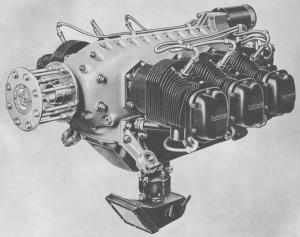
Continental C-115-2 |
Coincident with development of C-series 4-cylinder engines, Continental also embarked on development of 6-cylinder versions. The addition of two more cylinders facilitated a significant power improvement using a common set of parts. The 6-cylinder Continental designs may have also been in response to 6-cylinder Franklin and Lycoming engines, which had begun to receive type certificates in 1940 and 1941 respectively.
The A100 was the first 6-cylinder Continental engine to receive a type certificate, and it was based on the 6-cylinder C-series crankcase with the cylinder skirt holes bored 0.1875" undersize. Cylinder flange bolt patterns and sizes for both A- and C-series cylinders were identical.
Shortly after the A100 achieved type certification, two other 6-cylinder engines were certified. Both were based on the new 4.0625"-bore cylinder, but retained the 3.625" stroke, yielding a displacement of 281.9 in³. The C-115 produced 115 hp at 2,350 rpm. The C-125 produced 125 hp at 2,550 rpm. Both were rated for 73 octane fuel. Both weighed either 252 or 257 lb, depending on choice of magnetos. Continental submitted the C-115-1 and C-125-1 type certificate application on 8 Jun 1945, and finally received ATC No. 236 on 7 Nov 1945. Approval for the C-115-2 and C-125-2 was added on 16 may 1946.
These 6-cylinder engines introduced a new engine mounting concept, replacing the A- and C-series 4-cylinder planar mounts with a cradle mount incorporating four Lord synthetic rubber vibration isolators whose vibration-absorbing axes were in a plane passing through the engine's center of gravity. The C-115 and C-125 were identical except for maximum rpm and, in later C-125 models, ignition timing. Within this article, unless otherwise noted, the term C-125 will refer to both. |

